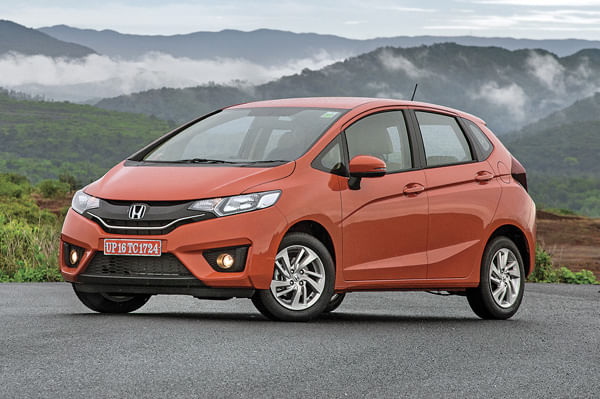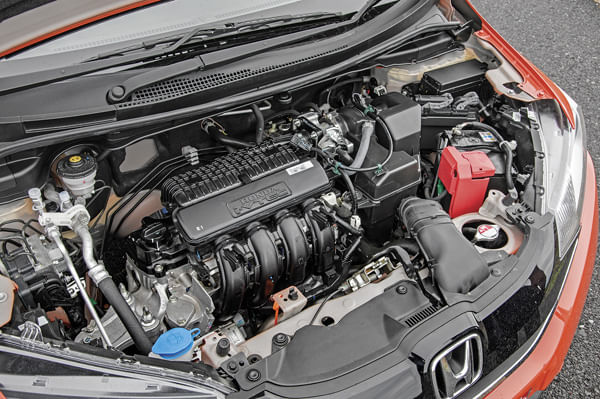1 This section right here contains the text that goes inside of the tooltip.
2 This section right here contains the text that goes inside of the tooltip.
3 This section right here contains the text that goes inside of the tooltip.
Honda’s cars have always been popular in India because of the many strong virtues ingrained in every car it makes. However, competitive pricing has never been one of them and the one car to suffer the most due to this factor was the last-generation Jazz. It had a wide set of talents which even cars twice its price would struggle to match. But with its price hovering close to the Honda City sedan, it was hard to justify the premium Honda was asking for, especially in a market like India where hatchbacks are perceived as budget buys.
But now, with the new one, thanks to heavy localisation, Honda has managed to pull down the price close enough to its main rival Hyundai i20. This alone makes it a formidable force in the premium hatchback market and unlike the old car, the new one also gets a diesel engine option which will surely get Honda more customers in the popular diesel market. It promises the same things that made its predecessor great – good looks, unmatched practicality, ease of use and fantastic reliability.
The latest Jazz may look like the old car, but underneath, it is all-new. It’s based on the new City platform, which is more rigid and lighter than the old one. The new Jazz is also 55mm longer and 10mm taller compared to the old car and even the wheelbase is stretched by around 30mm, which helps it generate even more interior space than before. Credit goes to Honda that despite the larger dimensions, the new Jazz is actually 10kg lighter than its predecessor. The new Jazz uses a conventional suspension layout. The front is suspended by independent MacPherson struts while the rear is a non-independent torsion beam.

The Jazz might have a brand new chassis but it still retains the old car’s silhouette and is easily recognisable. The fuel tank is still placed under the front seats which makes the boot deeper and liberates a lot of space in the rear. While the new car apes the predecessor’s raised central bonnet section, it uses more angular lines. Lots of interesting elements have been added to make the new car look more aspirational – the large, angular headlights that nicely blend with the multi-element grille look very striking. There’s a strong shoulder-line that runs across the side which gradually widens towards the large 3D-effect tail-lights. Despite these elements, the Jazz’s function-over-style shape is evident; it lacks the sporty stance of its rivals from Hyundai and Volkswagen and even looks a touch MPV from certain angles. That said, the tail is attractive and comes embellished with reflectors that flank the rear windscreen and a wide band of chrome that runs along the width of the boot.
The Jazz shares the dashboard with the City and it has a really funky design with a flurry of asymmetric cues. It is well thought-out, with nice touches, including multiple cubby-holes and the touch controls for the air-con. There are as many as nine cupholders and quite a few cubbyholes too, so you won’t find yourself short on storage spaces for small items. Quality is quite decent, but it still can’t match the Hyundai as far as fit and finish is concerned. Also, overall plastic quality, though largely good, is still a notch down on the class best.


The top Jazz VX trim comes equipped with a 6.2-inch touchscreen infotainment system. There’s also satellite navigation, a reclining back seat, automatic climate control with feather-touch operation, steering-mounted audio and Bluetooth controls, height adjustable driver’s seat, a rake and reach adjustable steering wheel and auto folding rear-view mirrors. On the safety front, it comes equipped with two airbags and ABS with EBD. Surprisingly, although it gets a reversing camera, there are no parking sensors.
The petrol Jazz still gets the same 1.2-litre i-VTEC motor, which we have extensively sampled in the Brio and the old Jazz. Like all modern Honda petrol engines, it is near-silent at idle and has good overall refinement. And while it’s available with a five-speed manual– like in the previous car – now, it also gets a CVT automatic option, making it even more city friendly.
Responses at low engine speeds are good and it gets off the line eagerly. But what lets it down is the weak mid-range. This means you will find yourself shifting down every time you want to pick up the pace and this can be a hindrance in some situations; like say, when you want to pull off overtaking manoeuvres on the highway. Like all Honda petrols, its real strength lies in its top-end and it gets a second wind if you rev it beyond 4500rpm. However, we don’t really see too many Jazz owners gunning all the way to the redline in everyday driving.

The five-speed gearbox, though, is a delight to use – very light and accurate, with short throws. The clutch is light too, which is a boon in traffic. If you don’t like to use the clutch or shift gears too much, Honda also gives you the option of an automatic transmission. The auto ‘box works really well in traffic and is quite responsive at low to medium speeds. However, ask for more power and the rubberband effect of the CVT gearbox pretty much eliminates the direct link between the throttle and engine responsiveness, and that takes away from the driving experience. There is a way to work around this somewhat though – as this is a step-CVT, you can shift between seven fixed ratios via the paddle-shifters. This makes the transmission more responsive and reduces the rubberband effect slightly. Overall, the automatic works very well in the city but out on the highway, it feels out of its comfort zone and the driving experience is quite dull. This reflects on the performance figures too. Where the manual variant reaches 100kph in a competent 14.20 seconds, the automatic takes a more leisurely 14.89 seconds.

Now, on to the biggest highlight on the car. Honda, with the new-gen Jazz, is offering a 1.5-litre diesel motor, the one from the City. The 1498cc i-DTEC diesel engine boasts all-aluminium construction, which makes it lighter than its direct competitors, and it sits on liquid-filled mounts instead of standard rubber ones to minimise vibration.
On start up, like experienced in the City, there’s a tremor from the front of the car as the motor rumbles to life; idle though, is reasonably quiet. Although it feels noticeably quieter in the Jazz than in the sedan, it still has a utilitarian feel to it – you can hear the clatter as soon as you get off the line and it never goes away. The vibrations can, in fact, be felt in the pedals too. This is mainly down to Honda using light-weight aluminium rather than iron (aluminium is not as good a sound insulator). The engine noise is still a bit of a sore point. But other than this, it is hard to fault the way this diesel engine feels on the move.
As soon as you set off, you’ll notice that there’s precious little turbo lag. Unlike most of its rivals, the Jazz diesel delivers its power in an extremely linear manner and the motor possesses a lot of elasticity. Although its peak torque of 20.4kgm is produced at 1750rpm, the Jazz has plenty of grunt right from idle and pulls strongly to about 3800rpm. The power then gradually tails off till it hits a very conservative 4200rpm rev limit. The Jazz diesel cruises quite well too, thanks to a reasonably tall sixth gear and the meaty torque spread. Honda has also made the gearing slightly taller as compared to the City to make it sound less stressed, especially on the highway. Interestingly, the clutch and gearshift action on the diesel variant has a bit more heft than the petrol car, but that’s more of an observation than a criticism.
On our timing equipment, the Jazz diesel managed an impressive 0-100kph time of 12.11sec, which makes it faster than the Hyundai i20. It could have been even faster had Honda not fitted it with a rev lock in the interest of engine preservation (it will not rev past 2000rpm when the car is stationary).
The Jazz hasn’t been designed to thrill you when shown a set of corners, but it does hold its own in terms of the way it drives. Pushing it hard into bends results in the tyres fighting for grip, but it isn’t half as bad as you may imagine from such slim rubber. Even the electric power steering feels quite accurate and retains its natural feel in the way it weights up. However, the feedback from the front tyres is very limited. At high speeds, the Jazz shows good composure and body control, even when suddenly met by a rough patch. But on the flip side, at low speeds, the ride isn’t exactly plush and sharper edges thump into the cabin easily. Still, it never feels uncomfortable and we feel that Honda has managed a good compromise between high and low-speed ride. In terms of stopping power, Honda has employed ventilated front discs and drums at the rear. Stopping power is more than adequate with progressive pedal feel.

The Jazz’s relatively light weight has a big role to play as far as fuel efficiency is concerned. In the city, the petrol manual delivered 12.3kpl and the auto managed 11.4kpl. Out on the highway, they managed an impressive 16.9kpl and 16.1kpl, respectively. The torquey 1.5-litre diesel gave us 14.4kpl in the city and 19.8kpl on the highway. When you consider the diesel’s overall 17.1kpl, it gives it a fantastic range of around 700km before you need to refuel your 40-litre tank.
Honda Jazz price for the base model starts at ₹ 8.57 lakh and the top model price goes upto ₹ 10.56 lakh (on-road Delhi).Honda Jazz comes in 7 variants.The Honda Jazz Petrol engine on road price in Delhi ranges between ₹ 8.57 lakh - ₹ 10.30 lakh.The Honda Jazz Diesel engine on road price in Delhi ranges between ₹ 9.12 lakh - ₹ 10.56 lakh.
 Honda Jazz ₹ 8.57 - 10.56 lakh Honda Jazz ₹ 8.57 - 10.56 lakh |  Maruti Suzuki Fronx ₹ 7.23 - 10.73 lakh Maruti Suzuki Fronx ₹ 7.23 - 10.73 lakh |  Hyundai Elite i20 NA Hyundai Elite i20 NA |  Volkswagen Polo ₹ 6.53 - 10.93 lakh Volkswagen Polo ₹ 6.53 - 10.93 lakh |
Engine 1199-1498 cc | Engine 1197 cc | Engine 1197-1396 cc | Engine 1197-999 cc |
Mileage 18.2-27.3 kpl | Mileage 22.35-22.94 kpl | Mileage 17.4-21.76 kpl | Mileage 17.21-21.49 kpl |
Fuel Type Diesel,Petrol | Fuel Type Petrol | Fuel Type Diesel,Petrol | Fuel Type Diesel,Petrol |
Airbags Yes | Airbags Yes | Airbags Yes | Airbags Yes |
Transmission Manual,CVT Auto | Transmission AMT Auto,Manual | Transmission Manual,CVT Auto | Transmission Manual,Dual-Clutch Auto |
Honda Jazz mileage starts at 18.2 kpl and goes up to 27.3 kpl.The Honda Jazz Petrol engine mileage starts at 18.2 kpl and goes up to 19 kpl.The Honda Jazz Diesel engine mileage is 27.3 kpl.
| Fuel Type | Displacement | Transmission | Mileage |
|---|---|---|---|
| Petrol | 1199cc | Manual | 18.2kpl |
| Petrol | 1199cc | CVT Auto | 19kpl |
| Diesel | 1498cc | Manual | 27.3kpl |
The Honda Jazz offers a variety of color options. Honda Jazz is available in a range of 5 colors. The colors offered in Honda Jazz are White Orchid Pearl, Lunar Silver Metallic, Modern Steel Metallic, Golden Brown Metallic and Radiant Red.
View all colours